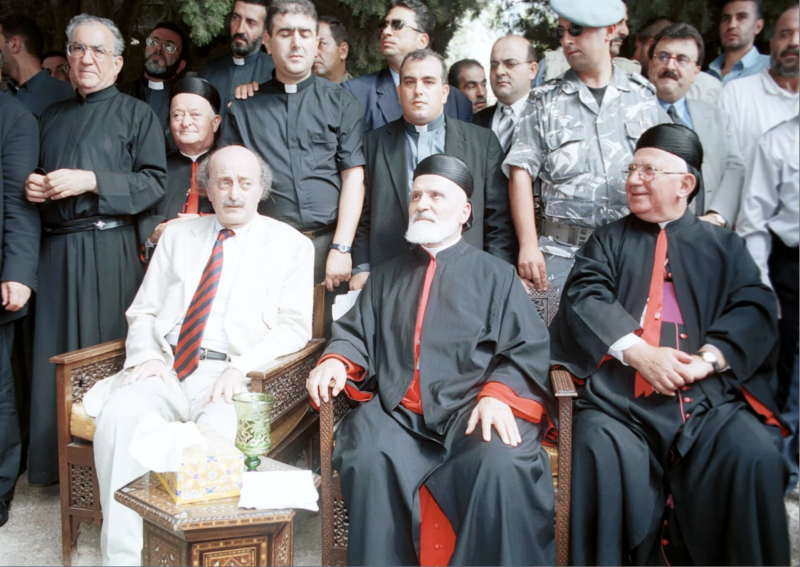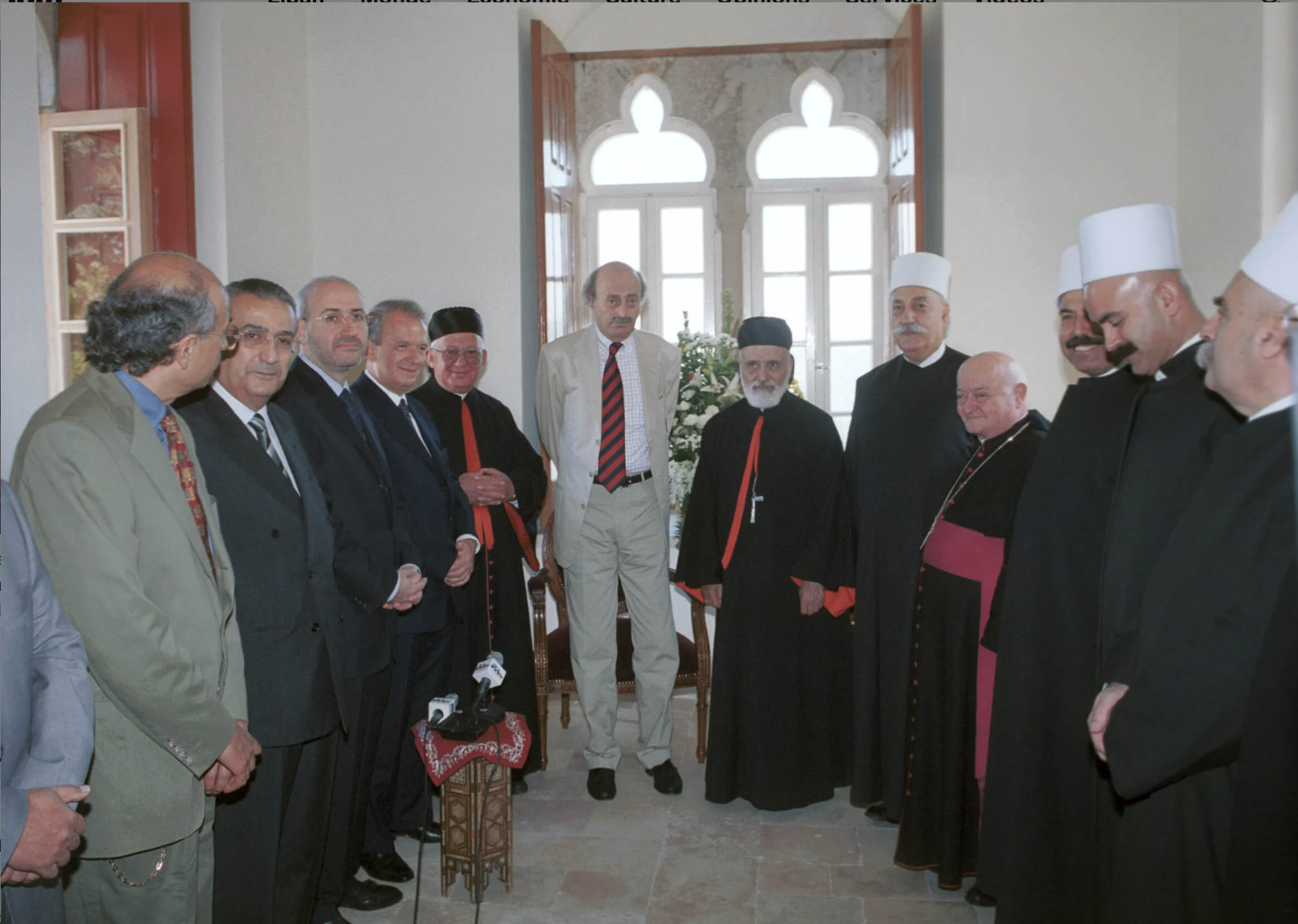
Former Progressive Socialist Party (PSP) leader Walid Jumblatt, and former Maronite Patriarch Nasrallah Sfeir, celebrating the "Reconciliation of the Mountain" in Mukhtara, August 2, 2001. (Credit : L'OLJ/Archives)
On Friday, in Mount Lebanon's Chouf district, Maronite Patriarch Bechara Rai embarked on a symbolic tour of one of the few Lebanese regions that established an official "reconciliation" process among its residents after the civil war (1975-1990).
Inhabited by Druze and Christians, the Chouf endured violence throughout history, particularly during the Lebanese Civil War. Among the worst of such events is the infamous Mountain War of September 1983. The district witnessed a historic reconciliation in August 2001, which marked the gradual return of many displaced Christians who had fled their villages following a series of massacres during that conflict. The War of the Mountain pitted the Christian militiamen of the Lebanese Forces against a coalition of parties supported at the time by Syria, which included the Progressive Socialist Party (PSP) led by Druze leader Walid Jumblatt.
Walid Jumblatt played a significant role in the 2001 reconciliation process, alongside then Maronite Patriarch, Nasrallah Sfeir.
Here is a timeline of key dates since the 1983 War of the Mountain, to the present day:
- September 3, 1983
The War of the Mountain began following the withdrawal of the Israeli army, which invaded Lebanon in 1982. It was a conflict fought between the Druze militiamen of the Progressive Socialist Party and Christian militiamen of the Lebanese Forces. Several massacres occurred at this time in various villages and towns in the Chouf, including Bhamdoun, Brih, and Kfarmatta.
Official casualty figures are unavailable, but some estimates suggest a death toll of around 2,500 on both sides.
The Mountain War resulted in the mass displacement of Christians from the Chouf, Aley, and Upper Metn (Baabda caza) areas, Approximately 100,000 people were displaced during this episode of the Civil War.
 Former Progressive Socialist Party (PSP) leader Walid Jumblatt and former Maronite Patriarch Nasrallah Sfeir, surrounded by local elected officials and Christian and Druze clerics, at the "Reconciliation of the Mountain," August 2, 2001, Moukhtara. (Credit : L'OLJ/Archives)
Former Progressive Socialist Party (PSP) leader Walid Jumblatt and former Maronite Patriarch Nasrallah Sfeir, surrounded by local elected officials and Christian and Druze clerics, at the "Reconciliation of the Mountain," August 2, 2001, Moukhtara. (Credit : L'OLJ/Archives)
- July 7, 1992
The Ministry of Displaced Persons is established. It is tasked with facilitating the return of all Lebanese citizens displaced during the Civil War, as well as reconciliation among communities.
- August 2nd, 2001
After years of gradual returns, the official "Reconciliation of the Mountain" between Druze and Christian inhabitants is declared. It is marked by a significant celebration that included the historic visit of Maronite Patriarch Nasrallah Sfeir to Mukhtara, Walid Jumblatt's hometown in the Chouf. The event marked a turning point in relations between Druze and Christians, and signified the desire to move beyond the scars of the Civil War. The 2001 reconciliation encompassed most Druze-Christian localities, with the exception of a few mixed villages, including Brih, Abey, and Kfarmatta.
- September 8th, 2007
In Kfarmatta in the Chahar el-Gharbi region (Aley caza), where many Christians witnessed their homes occupied by Druze, a reconciliation took place on September 8, 2007, at the Grand Serail in Beirut. This came after an initial unsuccessful attempt took place in 2006, led by Walid Jumblatt in Mukhtara.
In a 2018 interview with L'Orient-Le Jour, eleven years after reconciliation, residents of Kfarmatta expressed that many Christian families had still not returned to the village. While locals mentioned that eventually, all the displaced Christians reclaimed their homes, complete integration between the two communities was still not achieved.
Some estimates suggest that 142 people died in Kfarmatta during the Mountain War.
- 12th October 2010
The village of Abey eventually signed a reconciliation agreement on October 12, 2010, at the Grand Serail, sponsored by the Ministry of the Displaced.
The agreement also included the villages of Binnay and Ain Drafil.
- May 17, 2014
Brih was the last Druze-Christian locality to sign a reconciliation agreement on May 17, 2014, at the Beiteddine palace. The signing took place in the presence of then-President of the Republic Michel Sleiman, and Druze leader Walid Joumblatt. The reconciliation process had been preceded by a series of meetings sponsored by Akram Chehayeb, a close associate of Joumblatt who was Minister of the Displaced at the time.
- June 30, 2019
Free Patriotic Movement (FPM) leader Gebran Bassil made comments regarding the Mountain War and the 1983 clashes during a visit to Kahaleh (Aley). The comments were seen as an attempt to stoke sectarian tensions.
The following day while on a tour of the Aley caza, Bassil faced violent Druze protests in villages dominated by Jumblatt's PSP. Road blockades were organized in Kfarmatta, and the convoy of the Minister of State for Refugee Affairs, Saleh Gharib, a close associate of Talal Arslan's Democratic Party who had just met with Bassil in Chemlane, came under deadly fire as it passed the village of Qabr Chmoun.
Two of Saleh Gharib's bodyguards were killed in the clash.